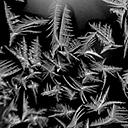Question
How do frost roses form on windows? Do they occur elsewhere?
Asked By
Guðmundur Karl
Answer
We have all probably seen frost roses that form on windows when there is frost outside. The way they form is closely related to the the way snow flakes form and depends on the same laws of physics. Frost roses form when hot and humid air comes into contact with a surface that is below freezing point, e.g. a window pane. The shape of frost roses is determined by many factors, how clean the glass is and its temperature, the temperature of the air and the level of humidity. Some window panes always produce the same frost rose pattern and others produce varying patterns. The water molecules only start to crystallise on the glass if several of them meet at the same place at the same time. With very smooth glass this is very unlikely to happen and most molecules will bounce off the surface. But if there are corrugations, scratches or even dirt on the surface then the molecules can get trapped, which greatly increases the possibility of them coming into contact with other molecules. So frost roses will tend to grow from indentations, scratches or impurities. If there are many such locations that enable crystallisation, or if the humidity increases rapidly in a short space of time (e.g. when there is a sudden change in temperature) then the frost roses will be small. If such conditions are few, the frost roses will only grow from a few locations and can become very large before they collide with others.
The shape of frost roses can vary greatly, but a closer inspection shows that there are certain patterns that are adhered to. Symetrical hexagons are dominant and easy to pick out.
With very smooth glass this is very unlikely to happen and most molecules will bounce off the surface. But if there are corrugations, scratches or even dirt on the surface then the molecules can get trapped, which greatly increases the possibility of them coming into contact with other molecules. So frost roses will tend to grow from indentations, scratches or impurities. If there are many such locations that enable crystallisation, or if the humidity increases rapidly in a short space of time (e.g. when there is a sudden change in temperature) then the frost roses will be small. If such conditions are few, the frost roses will only grow from a few locations and can become very large before they collide with others.
The shape of frost roses can vary greatly, but a closer inspection shows that there are certain patterns that are adhered to. Symetrical hexagons are dominant and easy to pick out. When water molecules crystallise, the least energy is needed to form hexagons (under abnormal conditions, e.g. at very low temperatures and/or very low pressure, there are other possible shapes). The first shape formed in a frost rose would normally be a tiny hexagon. As the corners of the hexagon protrude, they would be an irregularity on the surface of the glass and thus act as new starting points for crystallisation. All six corners are the same so six similar roses would grow from the corners of the hexagon. Small changes in temperature, humidity or air movement can stunt the growth of the roses growing out of the corners of the hexagon and provide conditions for the start of new roses. Crystallisation starts at these new points and the steps are repeated. The shape of the frost roses is often reminiscent of six christmas trees growing out from the same point.
All matter tends towards its the lowest possible energy state, and this is the same for ice. The ice crystal tries to minimise its surface energy by having its surface as homogenous as possible. The water molecule that adhere to the surface of a smooth crystal, breaks its uniformity and results in an increase in surface energy. This applies to molecules that adheres to the plane of the frost rose that faces into the room; it would be more efficient if it were to adhere to the edge of the system rather than to its flat surface. This causes frost roses to grow mainly in a two-dimensional plane, where they are normally thin in relation to the area they cover.
This answer also implies that such ice formations can occur in other locations where warm air meets surfaces with temperatures below zero. But it is not certain we would call such phenomena frost roses, as they would not be transparent.
Translated by Paul Richardson.
When water molecules crystallise, the least energy is needed to form hexagons (under abnormal conditions, e.g. at very low temperatures and/or very low pressure, there are other possible shapes). The first shape formed in a frost rose would normally be a tiny hexagon. As the corners of the hexagon protrude, they would be an irregularity on the surface of the glass and thus act as new starting points for crystallisation. All six corners are the same so six similar roses would grow from the corners of the hexagon. Small changes in temperature, humidity or air movement can stunt the growth of the roses growing out of the corners of the hexagon and provide conditions for the start of new roses. Crystallisation starts at these new points and the steps are repeated. The shape of the frost roses is often reminiscent of six christmas trees growing out from the same point.
All matter tends towards its the lowest possible energy state, and this is the same for ice. The ice crystal tries to minimise its surface energy by having its surface as homogenous as possible. The water molecule that adhere to the surface of a smooth crystal, breaks its uniformity and results in an increase in surface energy. This applies to molecules that adheres to the plane of the frost rose that faces into the room; it would be more efficient if it were to adhere to the edge of the system rather than to its flat surface. This causes frost roses to grow mainly in a two-dimensional plane, where they are normally thin in relation to the area they cover.
This answer also implies that such ice formations can occur in other locations where warm air meets surfaces with temperatures below zero. But it is not certain we would call such phenomena frost roses, as they would not be transparent.
Translated by Paul Richardson.
Images of frost roses.
Um þessa spurningu
Dagsetning
Published28.12.2005
Category:
Keywords
Citation
Halldór Svavarsson. „How do frost roses form on windows? Do they occur elsewhere?“. The Icelandic Web of Science 28.12.2005. http://why.is/svar.php?id=5517. (Skoðað 13.12.2025).
Author
Halldór Svavarssondósent við tækni- og verkfræðideild Háskólans í Reykjavík



